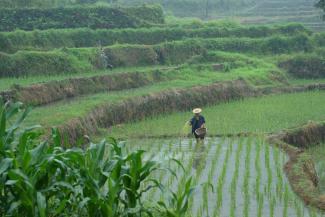Rural development
Globally Important Agricultural Heritage Systems
 Rice terraces in the Philippines.
Rice terraces in the Philippines.
According to the FAO website, a GIAHS is an agroecosystem inhabited by a community that lives in an intricate relationship with its territory. The FAO’s GIAHS programme has designated close to 70 sites in over 22 countries as relevant. These sites typically have remarkable agrobiodiversity as well as invaluable cultures and landscapes. Local communities manage them according to age old traditional knowledge.
Over centuries, many generations of farmers, fisher folk and herders developed these complex production systems, which suit the local environment well. The systems’ resilience is time-tested. The result is basic food security and livelihoods, as well as the conservation of natural resources, including biodiversity. Because a GIAHS represents a unique wealth of knowledge and resources it is indeed of international relevance.
The GIAHS programme is designed to identify such areas and protect them. The approach is in line with several international agreements, such as the UN Convention on Biological Diversity (CBD) or the International Treaty on Plant Genetic Resources for Food and Agriculture (ITPGRFA). Obviously, national governments and other national and international organisations must play their part too.
Fields, flocks, fisheries and forests
A GIAHS must not be misunderstood as a kind of museum. It is not a UNESCO World Heritage Site and must not be frozen in time. Throughout history, local communities have kept modifying and improving traditional practices. They must not stop doing so. The result would be degradation of the ecosystem and further impoverishment of its people. The resilience of a GIAHS depends on its peoples to adapt to new challenges without sacrificing, biological resources, cultural wealth or productive capacity. Local communities thus deserve support for enhancing the productivity of their fields, flocks, fisheries and forests.
The big challenge is to balance goals of conservation and development. They are not always compatible. It is essential to identify what might erode biodiversity and traditional knowledge. The goal must be to improve livelihoods without harming either. At the same time, local people could derive benefits from conservation and sustainable resource. They could be paid for facilitating eco-system services. Eco-tourism and eco-labelling are options too.
Policymakers at national and international levels have been focusing on industrial-scale agriculture (see main story). Indeed, a GIAHS today typically survives in an environmentally challenging area where industrial-scale agriculture is not feasible. GIAHS communities, however, are put at risk by global market trends, poverty and population. Inappropriate policies and poorly designed laws are harmful too. Insecure land tenure, for example, can undermine a GIAHS.
The focus must be on human development. Traditional knowledge is important because its socio-organisational, economic and cultural features are what facilitates resilience and sustainability. The implication is that traditional institutions must not be delegitimised, as they unfortunately all too often are.
The GIAHS programme is not about the past. It is about the future. The resilience of any agricultural system results from its level of diversity and its adaptation to the ecosystem. A GIAHS contains rich and unique agricultural biodiversity – both within and between species. Entire landscapes have been shaped by such interactions.
Dating back to ancient civilisations, many of these systems are linked to important centres where plant and animal species were originally domesticated millennia ago. Their in-situ conservation is of immense importance and global value. Gene banks are no alternative because they are frozen in time, while natural environments keep evolving (see Melaku Worede on www.dandc.eu).
Interventions must avoid cookie-cutter models. They must be locally specific and involve the local communities as decision-makers. The implication is that support for GIAHS communities will require ample resources and much time.
Therefore, each GIAHS must be accompanied by an Action Plan of Dynamic Conservation. Moreover, interventions must be experimental and flexible in design as well as content. Unfortunately, the FAO has concentrated more on the increasing the number of GIAHS and largely failed to properly provide concrete support to farming communities and implement action plans. Part of the challenge is therefore to make the general public understand how a GIAHS serves the global common good and thus deserves protection.
Link
GIAHS – FAO programme:
https://www.fao.org/giahs/en/
Parviz Koohafkan is the founder and president of the World Agricultural Heritage Foundation. He is a former director of the UN Food and Agriculture Organization (FAO) and started its Globally Important Agricultural Heritage Systems programme (GIAHS) 20 years ago.
parvizkoohafkan@gmail.com
https://worldagriculturalheritage.org/

